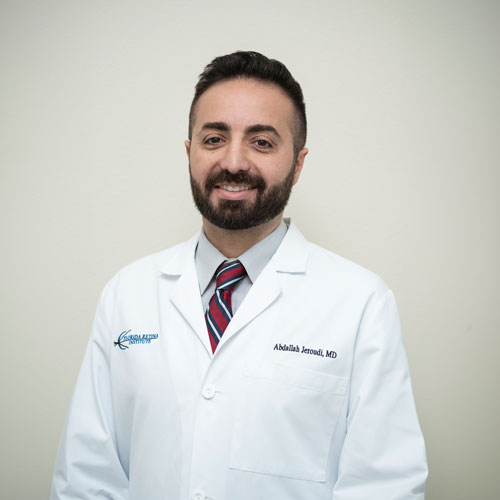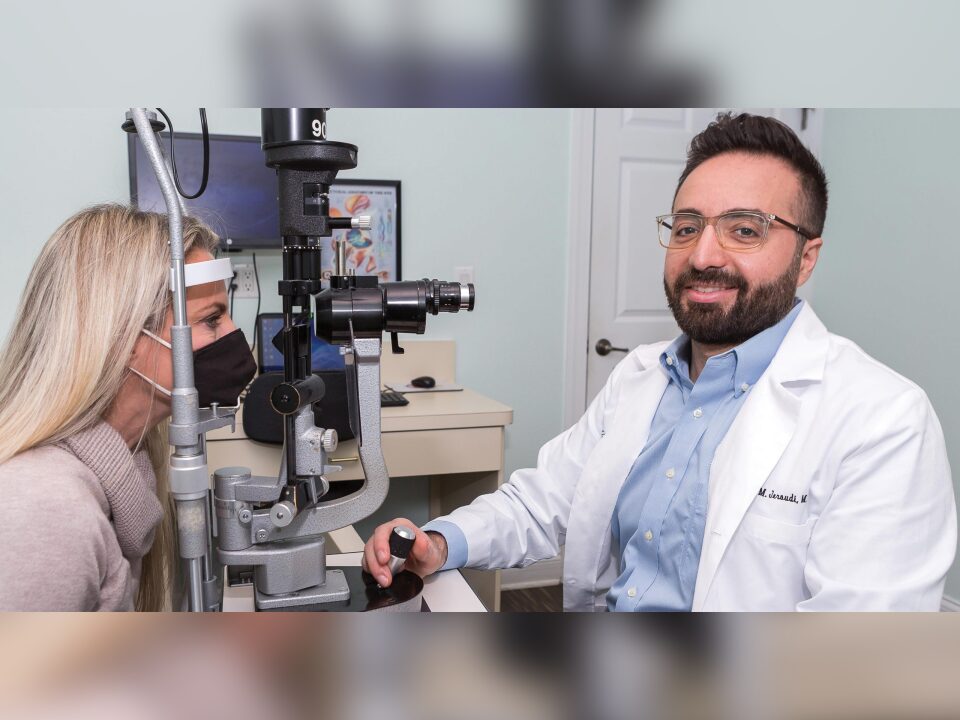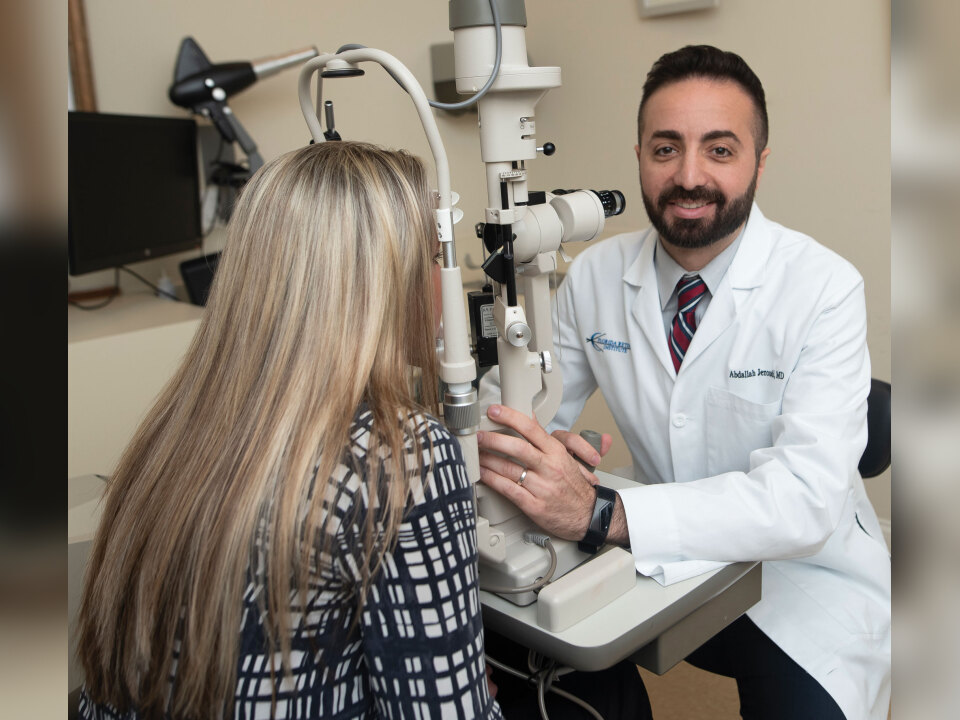It’s not uncommon for people in their 50s, 60s and 70s to develop age-appropriate “wear and tear” on their retinas, the light-sensitive layer of nerve tissue at the back of the eye. But in some of those people, this marks the beginning of a condition called age-related macular degeneration (AMD or ARMD).
“ARMD is an acquired degeneration of the central part of the retina that leads to central vision impairment,” elaborates Abdallah M. Jeroudi, MD, a board-certified, fellowship-trained retina specialist at Florida Retina Institute. “For reasons we do not fully understand, people with ARMD develop significantly more wear and tear on their retinas than the average person who does not have the condition.
“The slow, progressive eroding of the retina that occurs with ARMD is much like the eroding of the knee areas of your favorite pair of jeans. In the same way that, over time, your jeans wear and develop bare spots, ARMD leads to atrophy at the center of the retina, which diminishes vision.”
There are many risk factors for age-related macular degeneration. The biggest, of course, is age. The chances for developing ARMD increase from 2 percent for ages 50 to 59 to almost 30 percent for ages 75 and older. Other risk factors include smoking, being female, Caucasian ancestry, farsightedness, high blood pressure, light-colored eyes, coronary artery disease and a family history of ARMD.
“Smoking is a huge risk factor,” Dr. Jeroudi stresses. “People with ARMD who smoke are twice as likely as nonsmokers to develop significant vision loss related to macular degeneration.
“Smoking and other ARMD risk factors cause damage to the supporting layer of cells underneath the retina, called the retinal pigment epithelium, which in turn damages the overlaying retina. Technically, retinal pigment epithelial cells are located throughout the eye, but ARMD only affects those in the central retina. As a result, ARMD impacts central vision.”
Central vision is responsible for the most detailed vision, which we use to write, drive, read or watch television. ARMD does not harm peripheral vision, which is used to see landscapes at a distance or navigate while walking.
Typically, ARMD is diagnosed though an eye exam. People in the early stages of macular degeneration often describe general symptoms such as blurry vision or a feeling that their vision just isn’t “right,” especially when reading. They may experience distortion of their vision, which often prompts an eye exam appointment.
“During an eye exam, we dilate the patient’s pupils to get a good look at the back of the eyes, where the retina is located,” Dr. Jeroudi informs. “We look for specific findings consistent with ARMD, including little yellow spots on the retina called drusen. Drusen are the hallmark finding for macular degeneration. That’s how we identify it.”
Cracks in a Sidewalk
There are two forms of ARMD: dry, or nonexudative, and wet, or exudative. Dry ARMD is more common, accounting for 85 to 90 percent of ARMD cases. People with dry ARMD can, over time, progress to wet ARMD.
Dry ARMD is further divided into early, intermediate and advanced stages.
“With the early stage, we typically see a small amount of drusen on the retina. With the intermediate stage, there is significantly more drusen scattered on the retinas of both eyes,” Dr. Jeroudi reports. “With the advanced stage of dry ARMD, there are not only numerous drusen all over the retinas, there are also pigmented granules and areas of wear and tear on the retinas that are causing atrophy.”
“People with ARMD who smoke are twice as likely as nonsmokers to develop significant vision loss related to macular degeneration.” – Dr. Jeroudi
Wet ARMD presents with the same findings as advanced dry, with the addition of unstable blood vessels growing from the pigment epithelial layer underneath the retina. The process of blood vessel growth is called neovascularization.
“Imagine cracks in a sidewalk,” Dr. Jeroudi describes. “With neovascularization, unstable blood vessels grow through the cracks and leak fluid and blood onto the retina, severely affecting the central vision very rapidly. Contrast that to dry ARMD, which affects vision very slowly over years.”
There is no treatment for dry ARMD, although retina specialists are concerned about progression to wet ARMD, so they recommend special vitamins based on the findings of a follow-up clinical trial called the Age-Related Eye Disease Studies.
“This formulation is called AREDS2, and it contains vitamins C and E, copper, lutein, zeaxanthin and zinc,” Dr. Jeroudi observes. “We also ask our patients with dry ARMD to avoid smoking because it increases the risk of neovascularization.”
Treatment for wet ARMD is aimed at stopping the unstable blood vessels from leaking and causing significant damage to the retina. It involves intravitreal injections, which introduce medication directly into the eye cavity to shrink the blood vessels and stop neovascularization.
“These injections may sound scary, but the needle we use is only several human hairs thick,” Dr. Jeroudi assures. “And before we begin the injections, which we perform right in our office, we make sure the eyes are completely numb using special drops. We have a great track record of success in keeping our patients comfortable for this procedure.
“Intravitreal injections, like care for diabetes and high blood pressure, is not a one-and-done treatment. There is no cure for wet ARMD, so it can only be controlled and managed. Initially, injections are performed about every four weeks until blood vessel activity is controlled. Then, the injections are given at longer intervals to manage the control. Spreading out the injections also reduces the burden of treatment on the patient.”
Positive Prognosis
In addition to quitting smoking, Dr. Jeroudi encourages patients with dry ARMD to make lifestyle changes to reduce the risk of progression to wet ARMD and maintain their vision.
“Patients with a diagnosis of macular degeneration should protect their eyes from the sun by wearing sunglasses, control their high blood pressure and eat a healthy diet,” he urges. “It has been found that a poor diet is associated with decreased ocular health.
“We also ask patients to monitor their vision for any new distortion when looking at straight lines. Many retina specialists give their patients a special grid called an Amsler grid, which resembles a piece of graph paper. Patients are instructed to report back if the straight lines on the grid appear wavy, which may signal progression of ARMD.”
Dr. Jeroudi recommends that patients also monitor for any new blind spots. He suggests patients check their vision, one eye at a time, once a week. By doing this, they may catch the early signs of wet ARMD.
“Routine monitoring enables us to quickly diagnose wet ARMD and begin treatment right away,” he says. “And that greatly improves the patient’s vision prognosis.”







